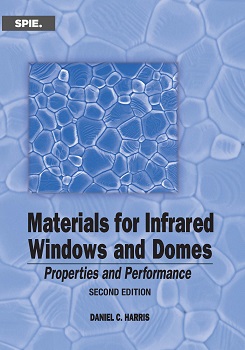Proceedings Article | 2 May 2007

KEYWORDS: Zinc, Chemical vapor deposition, Crystals, Infrared radiation, Absorption, Gas lasers, Manufacturing, Missiles, Optics manufacturing, Composites
By the mid 1950s, there was a need for infrared-transmitting materials with improved optical and mechanical
characteristics for military and commercial instruments. The newly invented "heat-seeking" missile also required a more
durable infrared-transmitting dome. Some properties of ZnS were known from studies of natural minerals. More
properties of pure ZnS and ZnSe were measured with single crystals grown in Air Force and industrial laboratories in the
1950s. In 1956, a team led by William Parsons at the Eastman Kodak Hawk-Eye Works in Rochester, New York began
to apply the technique of hot pressing to make infrared-transmitting ceramics from powders. This work led to
commercial production of six materials, including ZnS (IRTRAN® 2) and ZnSe (IRTRAN® 4) in the 1960s. Because
the hot pressed materials could not be made in very large sizes and suffered from undesirable optical losses, the Air
Force began to look for alternative manufacturing methods around 1970. Almost immediately, highly successful
materials were produced by chemical vapor deposition under Air Force sponsorship by a team led by James Pappis at the
Raytheon Research Division in Waltham, Massachusetts. Chemical-vapor-deposited materials replaced hot pressed
materials in most applications within a few years. From a stream of Air Force contracts in the 1970s and early 1980s,
Raytheon produced two different grades of ZnS for windows and domes, one grade of ZnSe for high-energy CO2 laser
windows, and a composite ZnS/ZnSe window for aircraft sensor pods. In 1980, a competitor called CVD, Inc., was
formed by Robert Donadio, who came from the Raytheon Research Division. CVD began with a license from Raytheon,
but soon sued Raytheon, arguing that the license violated the Sherman Antitrust Act. Raytheon countersued for breach
of employment contracts and misappropriation of trade secrets. In 1984, a jury ruled in favor of CVD, which went on to
build a lucrative business in ZnSe and ZnS. CVD was eventually purchased, first by Morton, and later by Rohm & Haas.
II-VI, Inc. was formed in 1971 by Carl J. Johnson and James E. Hawkey to produce CdTe optics for industrial CO2
lasers. When Raytheon introduced ZnSe into the market in 1974, it was obvious that ZnSe was superior to CdTe, so
II-VI purchased ZnSe from Raytheon to produce optical components. The supply of ZnSe was never stable enough for
II-VI, which therefore began its own effort to deposit ZnSe in 1975. In 1980, II-VI became an investor in and customer
of CVD, Inc., buying a substantial portion of the ZnSe that could be supplied by both Raytheon and CVD. Still pressed
to meet customer demand, II-VI built its first ZnSe production furnace in the period 1983-1986. A second furnace came
on line in 1988 and two more were operational by 1990. Finally attaining excess capacity, II-VI became a supplier of
ZnS as well as ZnSe. In 1990, Raytheon exited the ZnS and ZnSe business, leaving it mainly to CVD and II-VI.



